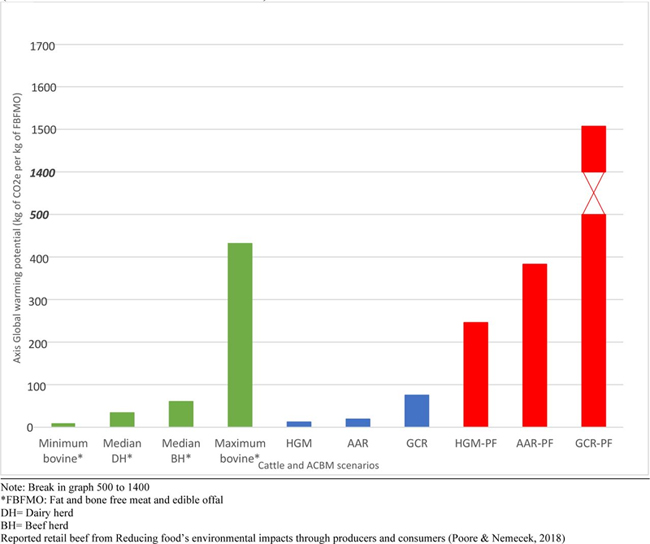MEAT produced from cells grown in a lab could be up to 25 times worse for the climate than beef, unless scientists find a way to alter energy-intensive production steps, according to an analysis by U.S. researchers.
Laboratory production of meat has been proposed as a more emissions-efficient and climate-friendly alternative to conventional meat. However, researchers at the University of California have found that the process of raising meat in the lab has a 25 times greater impact on global warming than traditional beef production.
Importantly, these findings are based on the use of the standard metric for assessing Global Warming Potential, meaning that the differentials would be even greater if assessed using GWP*, the revised, accurate metric for assessing stable emissions of short-lived gases such as methane.
The research team, which was led by Derrick Risner, used a number of life cycle assessment approaches to assess the emissions impact of animal cell-based meat against beef production systems.
The key finding was that “The GWP of all purified scenarios ranged from 246 to 1,508 kg of CO2e per kilogram of animal cell-based meat, which is 4 to 25 times greater than the median GWP of retail beef (∼60 kg CO2e per kg).”
In setting out their objectives the researchers say “Interest in animal cell-based meat or cultured meat as a viable environmentally conscious replacement for livestock production has been increasing, however a life cycle assessment for the current production methods of animal cell-based meat has not been conducted. Currently, animal cell-based meat products are being produced at a small scale and at an economic loss, however animal cell-based meat companies are intending to industrialize and scale-up production. This study assesses the potential environmental impact of near term animal cell-based meat production.”
“Livestock production is an integral component of the global food system,” the researchers say, “providing staple proteins (milk, eggs, and meat) consumed worldwide, contributing to crop productivity via utilization of manure as fertilizer, and providing critical nutrition and income to underprivileged households in low to middle income countries. Global meat production has increased from 70.57 million tonnes in 1961 to 337.18 million tonnes in 2020, though the consumption of different meat sources is highly regionalized.
“Looking forward, the overall [unchecked] demand for meat is expected to double by 2050, and this trend has raised concerns about the environmental impact of scaling up meat production to meet these expected demands. When the top three livestock production systems are examined from an environmental perspective, beef is the most impactful per kilogram, though this value varies significantly by production system.”
The researchers explain that multiple life cycle assessments have examined different beef production systems, and the global warming potential or GWP (kg of carbon dioxide equivalent, CO2-eq) was the most highly utilised environmental metric for these assessments.
They says that “Alternative proteins can be broadly categorized into three distinct categories: plant-based proteins, fermentation-based proteins, and animal cell-based meat or “cultured meat”. The core concept of animal cell-based meat production is that animal cells such as pluripotent stem cells can be proliferated in industrial scale bioreactors (>1,000 L), differentiated into a variety of cell types (e.g. adipocytes, myotubes, fibroblasts), and then processed for human consumption in place of conventionally produced meat. At the time of this writing, no animal cell-based meat products are produced at a large enough scale to be considered commercially available.”
In this study the life cycle assessment was conducted utilizing the ISO 14040 and 14044 standards (International Organization for Standardization, 2006b, 2006a). The work builds on existing process models developed in peer-reviewed techno-economic assessments of animal cell-based meat as well as an existing life cycle assessment of an animal cell growth medium.
- The life cycle impact assessment was conducted on both the base scenarios and scenarios with purified growth medium components.
- The GWP for all animal cell-based meat scenarios (19.2 to 1,508 kg of CO2e per kilogram of animal cell-based meat) was greater than the minimum reported GWP for retail beef (9.6 kg of CO2e per kg of fat and bone-free meat and edible offal).
- The GWP of all purified scenarios ranged from 246 to 1,508 kg of CO2e per kilogram of animal cell-based meat which is 4 to 25 times greater than the median GWP of retail beef (∼60 kg CO2e per kg).
It should be noted that the system boundary of this LCA stops at the animal cell-based meat production facility gate and does not include product losses, cold storage, transportation, and other environmental impacts associated with the retail sale of beef. Inclusion of these post-production processes would increase the GWP of animal cell-based meat products.
The fossil fuel depletion metrics were greater for all the animal cell-based meat production scenarios as compared to the low boneless beef metric.
Full details of the study can be found here

